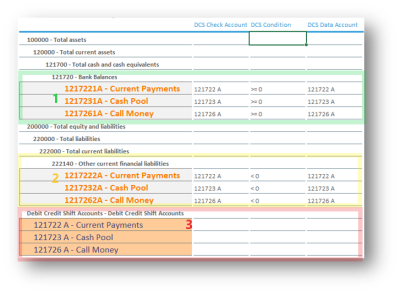Return to Models Overview
The financial position of a bank account or a set of bank accounts can be represented on a balance sheet by recording the overall balance on the asset (debit) side of the ledger when it is positive and moving it to the liability (credit) side of the balance sheet when the balance becomes negative. This move or shift from the asset to the liability side of the balance sheet ledger is referred to as a Debit Credit Shift.
The Debit Credit Shift for one bank account is implemented using three separate accounting elements with in the BS Account dimension:
| Element | Definition |
| Debit Credit Shift Accounts | Located outside the balance sheet. Holds the original data and can be positive as well as negative. |
| Total Assets | Represents the bank account only in case of a positive value. |
| Total Equity and Liabilities | Represents the bank account in case of negative values |
The example below shows how the accounts under Total Assets and Total Equity and Liabilities are populated automatically by rules from the first account located under Debit Credit Shift Accounts.
The value of the Debit Credit Shift Account populates the account 1217221A - Current Payments as long as the bank balance is greater than or equal to 0 (>= 0). If the bank balance is less than 0 (< 0) then the account 1217222A - Current Payments is populated with a positive value, this prevents the usage of negative values in the balance sheet report.
The sample data set below illustrates the implementation of a Debit Credit Shift in the Balance Sheet model.
The logic for the Debit Credit Shift is driven by the DCS Condition attribute. The Debit Credit Shift Accounts (3) element contains the account balances referenced by the DCS Check Account, DCS Condition and DCS Data Account attributes which populates the values of the Bank Balances (1) as well as the Other Current Financial Liabilities (2) elements used in the Balance Sheet reports.
The account that has the DCS Condition attribute set to >=0 or <0 will be populated if the balance on the account in the DCS Check Account attribute meets this condition. If so, the data from the account in DCS Data Account is populated.
To apply a line-by-line credit shift the DCS Data Account should be identical to the DCS Check Account. To perform the Debit Credit Shift on a group of accounts the DCS Check Account should refer to the consolidated account representing the account group while DCS Data Account should refer to base level accounts.
Note: after changing the DCS configuration in the attributes, the rule templates handling the Debit Credit Shift in the Balance Sheet cube need to be updated.
The three accounts under Total Assets, Total Equity and Liabilities and Debit Credit Shift Accounts must have individual element names. Follow a uniform naming convention to express the relationship between these three accounts.
The sample chart of accounts provided with the Balance Sheet model uses the following naming convention:
| Element | Naming Convention |
| Debit Credit Shift Accounts | Written with a blank space and A at the end (e.g. 121722 A for Current Payments) |
| Bank Balance | Written with a 1A at the end (e.g. 1217221A for Current Payments) |
| Other Current Financial Liabilities | Written with a 2A at the end (e.g. 1217222A for Current Payments) |

(1) Bank Balances elements under Total Assets, (2) Other Current Financial Liabilities under Total current liabilities (3) Debit Credit Shift Accounts[/caption]
For more information on the DCS Check Account , DCS Condition as well as the DCS Data Account attributes, please see the BS Account Dimension.
Updated September 25, 2024

